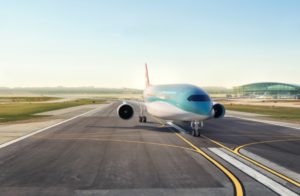Passengers could fly anywhere in the world with no carbon emissions and just one stop on board a concept aircraft unveiled by the Aerospace Technology Institute (ATI) today (December 6).
Up to 279 passengers could fly between London and San Francisco, USA direct or Auckland, New Zealand with a single stop with the same speed and comfort as today’s aircraft, a move which ATI says will revolutionise the future of air travel. The concept aircraft has been developed by a team of aerospace and aviation experts from across the UK collaborating on the government backed FlyZero project. The aircraft concept demonstrates the huge potential of green liquid hydrogen for air travel not just regionally or in short haul flight but for global connectivity. Liquid hydrogen is a lightweight fuel, which has three times the energy of kerosene and sixty times the energy of batteries per kilogramme and emits no CO2 when burned.
“Revolutionary vision for the future of global air travel”
FlyZero project director Chris Gear said: “At a time of global focus on tackling climate change our midsize concept sets out a truly revolutionary vision for the future of global air travel keeping families, businesses and nations connected without the carbon footprint. This new dawn for aviation brings with it real opportunities for the UK aerospace sector to secure market share, highly skilled jobs and inward investment while helping to meet the UK’s commitments to fight climate change.”
There are major technological challenges ahead to realising green liquid hydrogen-powered flight but a growing incentive and reward involved in resolving these. Together with other sectors also moving towards hydrogen energy, an increased demand is expected to lead to lower supply costs. A new generation of highly efficient hydrogen-powered aircraft with low fuel costs is forecast to have superior operating economics than conventional aircraft from the mid-2030s onwards.
Through the development of concept aircraft, FlyZero has identified the on board technologies which, together with the infrastructure and ground equipment for refuelling, require rapid development to deliver zero-carbon emission flight. These advanced technologies include wings without fuel tanks (dry wings), hydrogen tanks, cryogenic fuel systems, fuel cells and electrical power systems and hydrogen gas turbines.
In early 2022, detailed findings from the FlyZero project will be published including three final aircraft concepts (regional, narrowbody and midsize), technology roadmaps, market and economic reports and a sustainability assessment. These outputs will help shape the future of global aviation with the intention of gearing up the UK to stand at the forefront of sustainable flight in design, manufacture, technology and skills for years to come.
Kwarteng: “huge industrial opportunity for the UK”
Business Secretary Kwasi Kwarteng said: “These designs could define the future of aerospace and aviation. By working with industry, we are showing that truly carbon free flight could be possible, with hydrogen a front runner to replace conventional fossil fuels. Fuelling planes sustainably will enable the public to travel as we do now, but in a way that doesn’t damage the planet. It will not only help us to end our contribution to climate change, but also represents a huge industrial opportunity for the UK.”
Transport Secretary Grant Shapps added: “As we build back greener, it’s crucial that we place sustainability at the heart of the aviation industry’s recovery from Covid-19.This pioneering design for a liquid hydrogen-powered aircraft, led by a British organisation, brings us one step closer to a future where people can continue to travel and connect, but without the carbon footprint.”
“I look forward to continuing to work closely with the Jet Zero Council to support the UK’s world-leading research in this sector, which will create green jobs, help us meet our ambitious net zero targets and lead the global transition to net zero aviation.”
Protecting “the benefits of flying for future generations”
Jet Zero Council CEO Emma Gilthorpe said: “The Aerospace Technology Institute’s pioneering research highlights the potential for hydrogen in realising zero-carbon global connectivity. This ground-breaking green technology looks set to play a critical role in decarbonising flight and through the work of the Jet Zero Council, the UK aviation sector is exploring all avenues to ensure we protect the benefits of flying for future generations, while cutting the carbon cost.”
With a range of 5250NM, destinations including San Francisco (4664NM), Delhi (3642NM), Beijing (4414NM), Vancouver (4105NM), Mexico City (4815NM) and Rio De Janeiro (4983NM) are within reach from London. Destinations including Auckland (9911NM), Sydney (9188NM) and Honolulu (6289NM) are in reach with just one stop.
Powered by liquid hydrogen, the fuel is stored in cryogenic fuel tanks at around minus 250 degrees Celsius in the aft fuselage and two smaller ‘cheek’ tanks along the forward fuselage. These cheek tanks also serve to keep the aircraft balanced as the fuel burns off and eliminate the need for any additional aerodynamic structures.
The aircraft’s 54-metre wingspan carries two turbofan engines powered by hydrogen combustion. FlyZero’s midsize concept would meet the demands of a unique sector of the market between single aisle and widebody aircraft operations which together account for 93 per cent of aviation’s carbon emissions.

